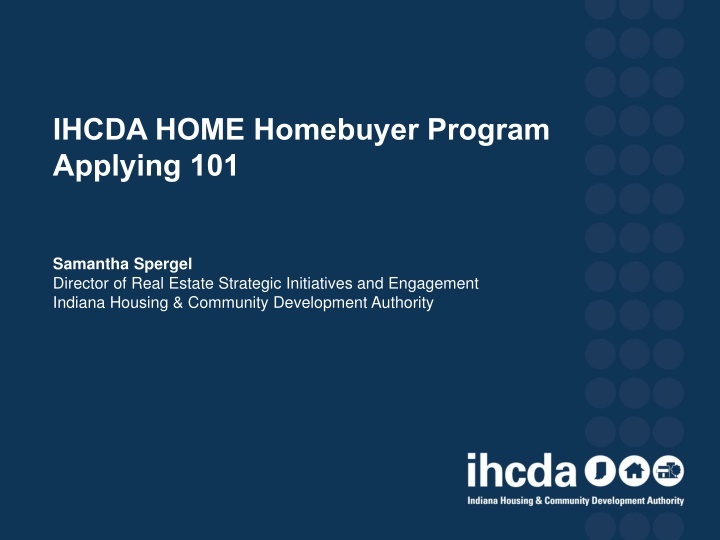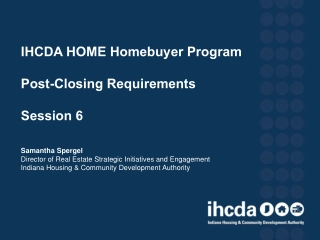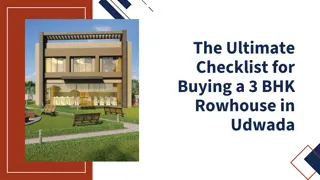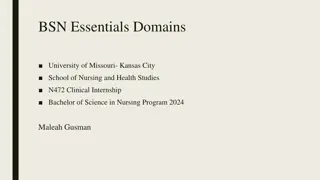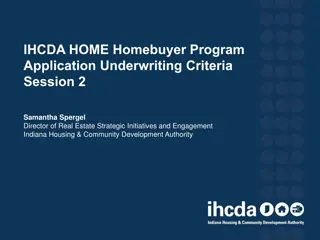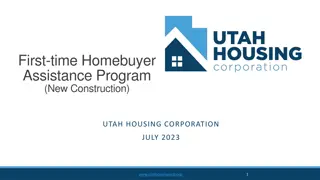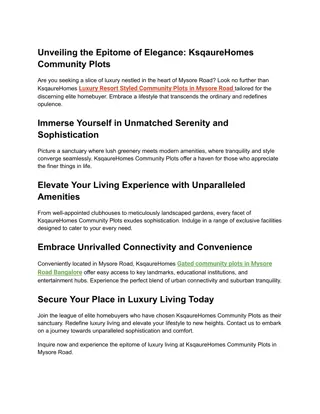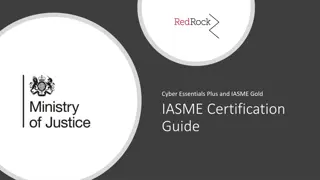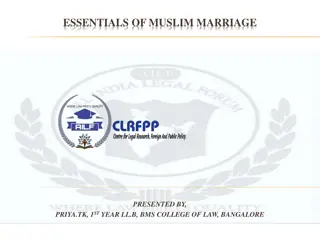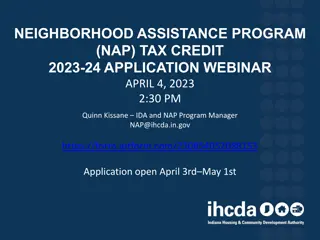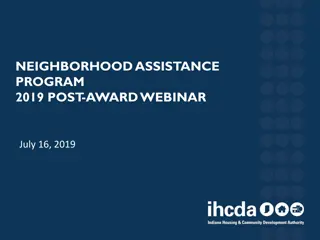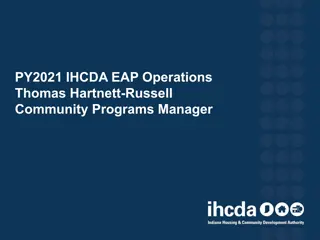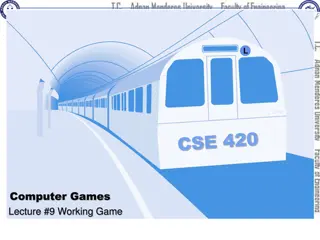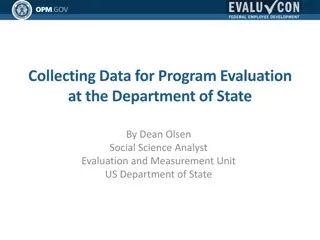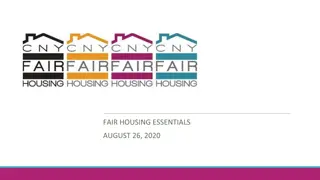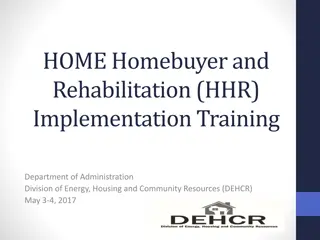IHCDA Homebuyer Program Essentials
Delve into the ins and outs of the IHCDA Homebuyer Program with this comprehensive guide covering eligibility, unit types, application process, and funding details. Discover the mission and vision of the Indiana Housing & Community Development Authority, along with key topics such as market need, development plans, and financing options.
Download Presentation

Please find below an Image/Link to download the presentation.
The content on the website is provided AS IS for your information and personal use only. It may not be sold, licensed, or shared on other websites without obtaining consent from the author.If you encounter any issues during the download, it is possible that the publisher has removed the file from their server.
You are allowed to download the files provided on this website for personal or commercial use, subject to the condition that they are used lawfully. All files are the property of their respective owners.
The content on the website is provided AS IS for your information and personal use only. It may not be sold, licensed, or shared on other websites without obtaining consent from the author.
E N D
Presentation Transcript
IHCDA HOME Homebuyer Program Applying 101 Samantha Spergel Director of Real Estate Strategic Initiatives and Engagement Indiana Housing & Community Development Authority
IHCDAs Mission and Vision Our Mission To provide housing opportunities, promote self-sufficiency, and strengthen communities. Our Vision An Indiana with a sustainable quality of life for all Hoosiers in the community of their choice.
Agenda What is HOME Homebuyer (why did I sign up for this?) Eligible unit types Who can apply? How to apply? Threshold Organization Structure and Capacity Market need and pipeline Site details Development plan Financing and Match Special Threshold topics Scoring
IHCDA Homebuyer Program Federal HUD program Provides subsidy to eligible non-profits and units of local government to support production of for-sale units Funds used for construction of housing and downpayment assistance Use of funds may be a grant or a grant + loan depending on how the project underwrites. Maximum award of $500,000. No maximum overall subsidy (but cannot exceed HUD limits) but some limits on grant and buyer subsidy portion. Units to be sold for households making at or below 80% AMI
Unit Types Property can be single-family, duplex, triplex, townhome or a building with no more than four units. Rehabilitation, new construction or rehabilitation/new construction paired with acquisition Manufactured homes may be eligible if they meet the IHCDA Manufactured Housing Policy or bring unit to federal standards (page 8 of draft policy). May do fee simple sale, condo or lease-purchase
Ineligible Unit Types Rental Housing Owner-Occupied Repair Group Homes Secondary Housing Attached to a primary Unit Nursing Homes Rehab of mobile homes Units within 100-year flood plain Units applying under RHTC program Standalone downpayment
Eligible Applicants Can be Units of Local Government that do not already receive HOME Community Housing Development Organizations (CHDOs) 501(c)3 and (c)4 PHAs Joint Venture Partnerships
Ineligible Geographies Following localities are not eligible for HOME funding: Bloomington Evansville Fort Wayne Gary Hammond Indianapolis Beech Grove, Lawrence, Speedway and Southport are eligible. Town of Cumberland is eligible outside Marion County Lake County Lafayette Consortium Includes Cities of Lafayette and West Lafayette and unincorporated areas of Tippecanoe County. Muncie South Bend Consortium Includes cities of South Bend and Mishawaka and unincorporated areas of St. Joe County.
Eligible PJs Proposed projects of Anderson, East Chicago and Terre Haute are eligible during PY 2023. PJ must also commit their HOME funds to the project.
Past HOME awards Any other HOME awards that the applicant has received from IHCDA must be drawn by a minimum of 25% of the award s total funding amount. HOME funds awarded within the last six months or those which have not received Release of Funds are exempt.
Funding Round Timeline Applications can be submitted on a rolling basis IHCDA staff will review the application process may take 1-2 months. IHCDA staff will review for threshold and scoring. IHCDA will send both a Threshold Letter and Preliminary Score Sheet. Environmental Review (more later) will be conducted simultaneously. All awards are subject to IHCDA Board of Director approval.
IHCDA Application Materials IHCDA application materials will be available on IHCDA s HOME Investment Partnership Program site Includes: Policy Application Pro-Forma Board Resolution Homebuyer Tabs ERR materials can be found on ERR site CHDO Application Workbook, Block Group, and Predevelopment Policy/Application on CHDO site
Application Submission No fee to apply! Please contact Chris Adkins at CAdkins@ihcda.IN.gov to set up a OneDrive folder for your application submission. Completed copy in both Excel and PDF of the Application Form Completed Pro-forma (one per unit)
Application Submission All supporting documents required in the tabs. PLEASE submit this information as separate, labeled PDF documents under the required labeled tabs. Please don t send one PDF of all supporting documentation. It will delay review significantly. Signed ERR record in PDF format Please notify Chris when all items have been uploaded.
Application Submission Application has three parts: Application form and Supplemental Materials Threshold Items Pro-Forma Scoring Application form includes questions on various items for threshold, and scoring. If you see anything not working correctly, please let IHCDA know!
Threshold Must include all applicable threshold items to be considered for funding Application form includes checklist
Threshold Items Organizational Structure and Capacity Who is building?
Application Cover Page Cover page basic information on organization. Lists important contacts and development team If you have additional contacts, just provide document with appropriate contacts for correspondence
Organizational Requirements Sam.Gov registration NEW! UEI number now required instead of DUNS Debarment documentation not required please make sure cover page includes all partners Architect license requirement Board Resolution required under State Statute. Can be found on IHCDA website If signing electronically, please also provide Bylaws or Amendment authorizing electronic signature
Organizational Capacity Non-Profit Applicant Documentation IRS Determination Letter Certificate of Assistance Audited Financial Statements Most recent copy of your audited financial statements. If you are not required to have audited financial statements, submit a compilation report put together by a third party OR your most current year-end financials. Year-to-Date Financials Most current YTD financials which includes both the balance sheet and income statement.
Administrator Documentation needed to show administrator has been properly procured via the Competitive Negotiation Procedure Signed copy of the RFP Submit advertisement of the RFP Signed agreement
CHDO Requirements If your organization wants to be certified as a CHDO: If you have not been certified with in 6 months of the application, please submit full CHDO application If you have been certified within past 6 months through separate Homebuyer application or HOME Rental application, please provide either: Letter from Executive Director stating nothing has changed since last certification, OR, Letter and documentation of any CHDO changes If you want to certify, and you have not received $50k of CHDO Operating in a given Program Year, you are eligible for CHDO Operating. See Tab D1 in Application form to apply.
Threshold Requirements Market Need and Pipeline Who is buying?
Market Need and Analysis A full market study is not required for HOME Homebuyer Want to demonstrate either: Have specific buyers lined up and tentatively selected (tend to see this with Habitat) OR Strong pipeline of buyers and partnerships Regulations pertaining to timing of selling the unit more on this later, but good to be cognizant of now when applying Think through scaling project to ensure units get sold
Market Need and Analysis Tab D2 Homebuyer Assessment Asks about pipeline and buyers identified. T3-Narratives Development Narrative: Development narrative provides information on the project, the amenities nearby, who the project will be serving, what partnerships have been developed to support the project and community support Tell the story of how your project will be successful! T3-Narratives Market questions include: What does the community look like? What is the market area? Is the community growing/is there high demand? Quantify the applicant pool (either wait list, or use data on need) Capture Rate & Absorption Period
How will you work with buyers? T3- Narrative Program Guidelines How will you accept application? How to you target the population you are serving? How do you evaluate applications? Require Grievance Procedure Policy How grievances are submitted Who will review those Timeframe for review Appeals process
How will you work with buyers? Tab D6 LEP (Meaningful Access for Limited English Proficient Persons) Please describe meaningful actions to ensure access to the project Housing Counseling more in a future application Will need narrative describing the services to be provided to a homebuyer Regulations pertaining to who can provide housing counseling
Threshold Requirements Site Details Where are we building?
What is the site? Submit clear, colored site map and site photos Zoning approval letter no older than six months from the appropriate, authorized governmental official certifying that the current zoning allows for construction and operation of the proposed development Lists any variances that were also required If the project is still undergoing the approval process, IHCDA will not move forward on reviewing the project until the zoning is approved.
Site Control Purchase Option or Purchase Agreement that expires no less than 30 days after the award announcement date or an executed and recorded deed. Recommend that Option expires no less than 3 months after submission to IHCDA Title Search which shows evidence of clear title with a title insurance commitment, title search documentation, or an attorney s opinion letter. Tax Sale special considerations: Tax Title deeds to do not warrant that the property is free of all liens and encumbrances. Warranty deeds do, but county governments won t guarantee clear title Would probably then rely on Attorney s Opinion or a Quiet Title Action
Environmental Review Environmental Review process governed under the National Environmental Policy Act of 1969; IHCDA pairs this with the National Historic Preservation Act of 1966 (Section 106 review). Environmental Review Workbook and all required supplemental documentation must be included. IHCDA ER site includes User s Guide, Workbooks, Resource Document (ie a How to Guide), Supplemental worksheets and Example Maps. Training on ERR to be August 29th. Contact Meagan Heber at mheber@ihcda.in.gov if you want to sign up.
ER considerations Please note that IHCDA will not fund projects in a 100-year flood plain, or projects that involve mapped or potential wetlands. Projects must not be within 2,500 feet from the end of a runway at a civil airport. New construction requirements near busy roadways, intersections, highways and railroads may be of concern. Noise above 75 dB is considered unacceptable under the Act and will require a new location. Noise between 65-75 dB will require mitigation. Project on or near a Superfund, CERCLA, solid/toxic waste disposal site, underground storage tank may require mitigation and other requirements.
Section 106 All new construction units must under a 30-day archeology review with the State Historic Preservation Office Consulting Party letters applicants must consult with outside parties and provide these letters with their application If these are not done at time of application, this will delay funding IHCDA will request a word document of the consulting party letter for tribal consultation which must come from IHCDA.
ER Feasibility and Timing IHCDA encourages partners to use the workbook to determine if a site and site plan may or may not be feasible. Timing on ERR is critical! Cannot execute an option or purchase property once the application for HOME funding is submitted to IHCDA if this occurs, IHCDA will not be able to put HOME funds into the unit. This is called a choice limiting action .
Conversion to Exempt Applicants are to fill out the workbook in full. IHCDA or their third party, SJCA will determine if the project will convert to exempt. Two criteria must be met to convert: The project is either 4 or less units on one site, or five or more units scattered sites, when the sites are more than 2,000 feet part and there are also not more than 4 units on any one site, AND, The development must not require compliance or additional consultation with regulatory authorities If the project does convert, IHCDA will send a ROF letter no public comment period is needed. If it does not convert, 45-day public comment period is needed.
Threshold Requirements Development Plans What are we building?
Development Budget & Appraisals Submit detailed construction cost estimates for the development. IHCDA will need this for each unit as each unit has to be individually underwritten. If not put together by an engineer or contractor, please provide information as to how the estimates were generated. IHCDA will use either the purchase agreement, or an As-Is appraisal to determine market value of the property pre-new construction/rehab. IHCDA may allow for a Comparative Market Analysis. Contact IHCDA prior to application submission. As-Is appraisals will be required if using HOME for acquisition.
Development Budget & Appraisals While not required with application, an Appraisal to determine sales price ( After Development Value ) can be submitted with application. This helps determine the amount of HOME needed for the project. Otherwise, provide comps to justify the proposed sales price. If an appraisal is provided, no additional appraisal is needed to be submitted to IHCDA when selling the unit. If an appraisal is not provided, it will be required prior to closing. If you are planning on using the HOME funds for acquisition, the cost of the eligible HOME costs will be based upon the lesser of the actual value paid for the property, or the appraised fair market value from the as-is appraisal.
Unit Plans & Design Provide site plans that show how the development is to be built, including: Demolition Existing Buildings Placement and Orientation of new and existing buildings, parking, sidewalks, amenities Location and size of any proposed commercial areas Scaled drawing elevations for all building types Rehab projects may submit renderings or photos if they are accompanied by an architect s certification that elevations will not change. Unit and Floor plans that include the square footage for each unit. Cannot be handwritten. Habitat Affiliates: if the specific unit and floor plan has not been determined, submit a variety of plans. Tab T4 Units Tab will identify numbers of units, number of bedrooms per unit, and projected AMI target for each unit.
New Construction Requirements All new construction homebuyer units must meet the visitability standard. All units must also be made accessible upon the request of the prospective buyer. Visitability is a design concept that allows persons with mobility impairments to enter and stay in a residence. Requirements include: At least one zero-step entrance on an accessible route. Can be any entrance to the unit. All main floor interior doors (including bathroom and closets) must provide at least 31 inches of clear opening width. At least one half or full bathroom on the main level that is accessible. Each hallway on the first floor had a width of at least 36 inches and is level, with ramped or beveled changes at each door threshold. Each bathroom on the first floor is reinforced for potential installation of grab bars. Each electrical plug or receptacle is at least 15 inches above the floor.
Rehabilitation Requirements Units to be rehabbed must be inspected by IHCDA or its third Party, Van Marter to confirm the construction cost estimates. IHCDA may require changes to cost-estimates and the pro-forma based on those results. Units built prior to 1978 must include a risk assessment with their application and include removal of lead-based paint as part of their scope. There are strict licensing requirements on who can remove lead paint. Please contact Dave Pugh at dpugh@ihcda.in.gov for further guidance. IHCDA further recommends including other hazard removal (ie asbestos) as part of the construction cost estimates.
Construction Standards Units must, at a minimum meet the stricter of the local rehabilitation standards or the Indiana State Building Code. Any units utilizing gas appliances must provide carbon monoxide detectors in addition to standard smoke detectors. Units must meet additional energy efficiency standards for new construction as required under Chapter 11, and the appliable amendments to the 2020 Indiana Residential Code.
Additional Design Considerations Universal Design form is not required with application. At least two features from each section of the form must be adopted in each unit (not all units must have same features!). Features in Section A are high cost; Section B are considered moderate cost, and C are Low cost. You can elect to do additional Universal designs from each column for points (3-5 points).
Additional Design Features - Scoring Design and Green Building Features are available for points. IHCDA also has new scoring category for HERS rating below 65. If considering any additional design features for points, these can be put into your budget and may be HOME eligible.
Threshold Requirements Other Funding What are the other sources in the project?
Funding Commitment HOME regulations require PJs (IHCDA) to ensure projects have all financing lined-up prior to entering into a contract. Must have letter of commitment or agreement with funder included as part of application. Letter must be signed by highest official, on letterhead and in PDF. Can accept conditional agreements/letters If funds were committed more than one year prior to submission, provide a letter confirming funds are available/accessible SOURCES = USES
